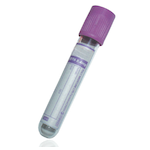Suitable Specimen Types
- Serum
- EDTA Plasma
- Li Hep Plasma
Specimen Transport
First class postSample Processing in Laboratory
Place sample in toxicology rack.Sample Preparation
None requiredTurnaround Time
3 days.Sample Stability
Keep refrigerated. 4 degrees.Amitriptyline & Nortriptyline
General Information
Amitriptyline is a tricyclic antidepressant drug that was first synthesized in 1960 and released for clinical use in 1961. The compound is administered either orally of by intramuscular injection in maintenance doses of up to 150 mg daily for outpatients or up to 300 mg daily for hospitalised patients.
Amitriptyline is extensively metabolised to a series of more polar compounds, these include nortriptyline, a major plasma constituent which may be responsible for the antidepressant effects of its parent, and dinortriptyline which may be active and is found to a certain extent in plasma. Nortriptyline may be prescribed itself as an active antidepressant agent.
The adverse effects of amitriptyline therapy include drowsiness, blurred vision, dry mouth, postural hypotension and dizziness. Amitriptyline has been found to impair skilled performance and to be additive with ethanol in its adverse effects. In overdose, patients may experience coma, seizures and cardiac abnormalities.
Physostigamine, a cholinergic drug, has been used successfully in the diagnosis and antidotal therapy of poisoning with amitriptyline and other tricyclic antidepressants.
Patient Preparation
For TDM, sample should be taken prior to dose. If toxicity is suspected, take sample at earliest opportunity
Notes
Amitriptyline & Nortriptyline measured by LC-MS/MS
Please note this assay is not currently UKAS accredited
Reference Range
In therapeutic use, plasma concentrations for the two drugs combined do not usually exceed 300 ug/L, with symptoms associated with toxicity observed at levels greater than 500 ug/L. (Clarke's Analysis of Drugs & Poisons, Third Edition)
Specifications
- EQA Scheme?: Yes
- EQA Status: LGC QUARTZ, LGC CLIN TOX
